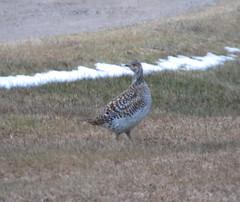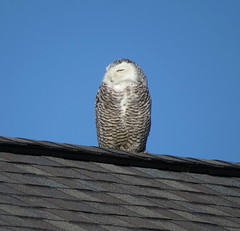A few years back around Thanksgiving I did a series of blog posts with some fun facts about that noble bird, the Wild Turkey. And as families gather together to break bread and give thanks I thought besides just filling ourselves with wonderful food, I’d try to fill our birding brains with some info about this great Upland Game Bird.
Only found in North America, the Wild Turkey has 6 distinct sub-species that I’d like to share.
There are subtle differences in the coloration, habitat, and behavior of the different subspecies of wild turkeys. The six subspecies are:
Eastern wild turkey (Meleagris gallopavo silvestris) (Viellot, 1817)
This was the turkey species Europeans first encountered in the wild: by the Puritans, the founders of Jamestown, and by the Acadians. Its range is one of the largest of all subspecies, covering the entire eastern half of the United States from Maine in the north to northern Florida and extending as far west as Michigan, Illinois, and into Missouri. In Canada, its range extends into Southeastern Manitoba, Ontario, Southwestern Quebec (including Pontiac, Quebec and the lower half of the Western Quebec Seismic Zone), and the Maritime Provinces. They number from 5.1 to 5.3 million birds. They were first named ‘forest turkey’ in 1817, and can grow up to 4 ft (1.2 m) tall. The upper tail coverts are tipped with chestnut brown. Males can reach 30 lb (14 kg) in weight. The eastern wild turkey is heavily hunted in the Eastern USA and is the most hunted wild turkey subspecies.
Osceola wild turkey or Florida wild turkey (M. g. osceola) (Scott, 1890)
Most common in the Florida peninsula, they number from 80,000 to 100,000 birds. This bird is named for the famous Seminole leader Osceola, and was first described in 1890. It is smaller and darker than the eastern wild turkey. The wing feathers are very dark with smaller amounts of the white barring seen on other subspecies. Their overall body feathers are an iridescent green-purple color. They are often found in scrub patches of palmetto and occasionally near swamps, where amphibian prey is abundant.
Rio Grande wild turkey (M. g. intermedia) (Sennett, 1879)
The Rio Grande wild turkey ranges through Texas to Oklahoma, Kansas, New Mexico, Colorado, Oregon, Utah, and was introduced to central and western California, as well as parts of a few northeastern states. It was also introduced to Hawaiʻi in the late 1950s. Population estimates for this subspecies range from 1,022,700 to 1,025,700.[53] This subspecies, native to the central plain states, was first described in 1879, and has relatively long legs, better adapted to a prairie habitat. Its body feathers often have a green-coppery sheen. The tips of the tail and lower back feathers are a buff-to-very light tan color. Its habitats are brush areas next to streams, rivers or mesquite, pine and scrub oak forests. The Rio Grande turkey is gregarious.
Merriam’s wild turkey (M. g. merriami) (Nelson, 1900)
The Merriam’s wild turkey ranges through the Rocky Mountains and the neighboring prairies of Wyoming, Montana and South Dakota, as well as much of the high mesa country of New Mexico, Arizona, southern Utah and The Navajo Nation, with number from 334,460 to 344,460 birds.[citation needed] The subspecies has also been introduced into Oregon. The initial releases of Merriam’s turkeys in 1961 resulted in establishing a remnant population of Merriam’s turkeys along the east-slope of Mt. Hood and natural immigration of turkeys from Idaho has established Merriam’s flocks along the eastern border of Oregon.[54] Merriam’s wild turkeys live in ponderosa pine and mountainous regions. The subspecies was named in 1900 in honor of Clinton Hart Merriam, the first chief of the U.S. Biological Survey. The tail and lower back feathers have white tips and purple and bronze reflections.
Gould’s wild turkey (M. g. mexicana) (Gould, 1856)
Native from the central valleys to the northern mountains of Mexico and the southernmost parts of Arizona and New Mexico. Gould’s wild turkeys are heavily protected and regulated. The subspecies was first described in 1856. They exist in small numbers in the U.S. but are abundant in northwestern portions of Mexico. A small population has been established in southern Arizona. Gould’s are the largest of the five subspecies. They have longer legs, larger feet, and longer tail feathers. The main colors of the body feathers are copper and greenish-gold. This subspecies is heavily protected owing to its skittish nature and threatened status.
South Mexican wild turkey (M. g. gallopavo) (Linnaeus, 1758)
The south Mexican wild turkey is considered the nominate subspecies, and the only one that is not found in the United States or Canada. In central Mexico, archaeological M. gallopavo bones have been identified at sites dating to 800–100 BC [10], [11]. It is unclear whether these early specimens represent wild or domestic individuals, but domestic turkeys were likely established in central Mexico by the first half of the Classic Period (c. AD 200–1000). Late Preclassic (300 BC–AD 100) turkey remains identified at the archaeological site of El Mirador (Petén, Guatemala) represent the earliest evidence of the export of the Mexican turkey (Meleagris gallopavo) to the ancient Maya world. The Mexican subspecies, M. g. gallopavo, was domesticated, either in Mexico or by Preclassic peoples in Mesoamerica, giving rise to the domestic turkey.[55] The Spaniards brought this tamed subspecies back to Europe with them in the mid-16th century; from Spain it spread to France and later Britain as a farmyard animal, usually becoming the centerpiece of a feast for the well-to-do. By 1620 it was common enough so that Pilgrim settlers of Massachusetts could bring turkeys with them from England, unaware that it had a larger close relative already occupying the forests of Massachusetts. It is one of the smallest subspecies and is best known in Spanish from its Aztec-derived name, guajolote. This wild turkey subspecies is thought to be critically endangered, as of 2010.
All this information was copied from the internet.
So my question to all my loyal readers, how many different sub-species have you seen? For myself, and just recently been birding in Texas, that would be 2 for me.
In closing I’d like to leave you with one of my favorite hymns that always seems to pop into my head this time of year.























































